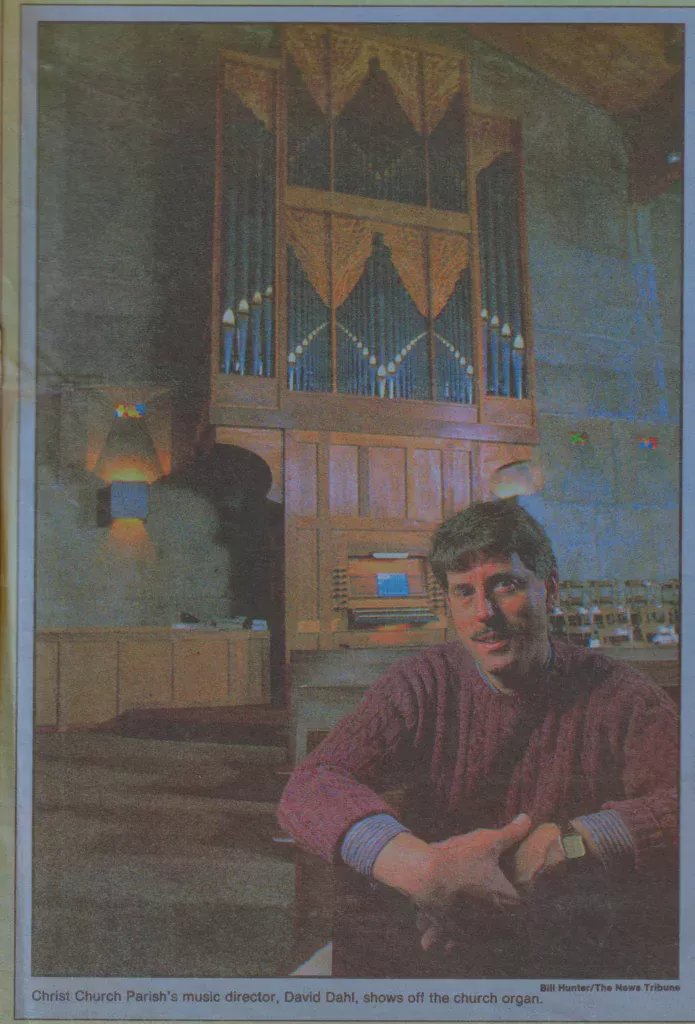During an additional third year in the music graduate school at the University of Washington, David Dahl secured a job playing for Sunday night services at University Presbyterian Church, where he accompanied the college-age choir directed by Robert Scandrett. Concurrently, Whitworth College in Spokane, WA, had acquired a new Moller organ and was in need of an organist following the retirement of the incumbent. Robert Scandrett recommended Dahl to Milton Johnson, chair of the music department at Whitworth, for the music faculty position. At the time of the recommendation, Dahl was attending the Andover Organ Institute in Massachusetts. Just hours after receiving the offer, Dahl consulted with E. Power Biggs at his home in Boston, who advised him to accept the job regardless of his low opinion of the organ itself. Heeding this advice, Dahl canceled his plans to visit Europe that summer and traveled from Boston to Spokane by train.
True to Biggs’ prediction, Dahl found the organ uninspiring and the acoustics lacking due to the room’s cork walls, which led him to initially withdraw from the position. However, after being urged by the Whitworth music chair to reconsider, Dahl accepted the role and spent five years at Whitworth. During his time there, he began his “tracker missionary work,” persuading Messiah Lutheran Church to commission a Bosch tracker organ, and becoming their organist.
In 1961, Dahl met Glenn White and they bonded over a shared passion for tracker organs, leading to the formation of the Olympic Organ Builders. Their first success was the sale of a Werner Bosch-built organ to Mountain View Lutheran Church in Edgewood, WA. Although they didn’t profit financially from the business other than the purchase of an electric typewriter for each of them, they succeeded in leaving a tangible legacy of tracker organs across the Northwest.
St. Mark’s Cathedral in Seattle acquired a Flentrop tracker organ in 1965, and while still at Whitworth, Dahl was invited to perform their annual all-Bach recital, which caught the attention of Maurice Skones, chair of music at Pacific Lutheran University. In the spring of 1969, Skones offered Dahl a teaching position at PLU, which he readily accepted, joining as an assistant professor of music in the fall. Dahl’s responsibilities included teaching organ, music history, and church music classes, with an enrollment of 35 organ students supported by assistants Mary Helen Thompson and David Locke.
Around Easter 1970, Christ Episcopal Church,Tacoma, having recently built a new sanctuary and moved an Allen electronic “organ” from the old church, sought Dahl as their organist. Initially declining the offer, Dahl reconsidered when approached again after a failed first hire, driven by a vision of a grander organ fitting the sanctuary. As expected, the Allen began malfunctioning, producing static and other objectionable noises in addition to its baseline objectionable noises. Although other organists had been known to sabotage their electronic devices in order to get real organs, Dahl denies having done so. In any case, the Allen’s failure facilitated the commissioning of a tracker organ from John Brombaugh by 1975.

The chancellor (church attorney) was not a supporter of acquiring a new organ, and wrote to John Brombaugh, threatening, “For every day this organ is late, you will pay a fine of $100.” Church member Bill Gill, on behalf of the organ committee, wrote Brombaugh advising him to disregard the chancellor’s letter. However, Brombaugh by that point was miffed and withdrew from the contract. Dahl went to visit Gill at his Lincoln Mercury dealership. Gill, who had become convinced that the Brombaugh organ was in the best interest of the church, said, “Let’s get John Brombaugh on the horn.” They did, and Bill Gill told Brombaugh, “You are the organ builder we want for this job. Will you reconsider?” After a long pause, John said, “Yes,” but as apparent punishment, he removed the third manual from the contract.
The initial Brombaugh proposal included a 2-foot division on the second keyboard and a 5-rank cornet on a third half manual. While considering the specifications, Dahl attended an organ institute at Oberlin with Harald Vogel. On the closing day, at a party at the home of Professor David Boe, David Dahl showed Dutch organist Klas Bolt the Brombaugh proposal. Bolt said, “What are you going to do with that 2-foot division? You can’t accompany the congregation. Are you going to play a lot of continuo? How much height do you have?” Dahl answered, then Bolt said, “Why aren’t you getting an organ with a bovenwerk based on a 4-foot principal?” Dahl realized Bolt was right, and called John Brombaugh. Brombaugh, who coincidentally, was building two organs with similar specifications, offered to add Christ Church as a third, at a cost of about $5000 more than had been approved by the vestry. The church, of course, found the additional funds.
Dahl spent his summers and breaks attending historic organ tours and performance institutes, traveling to Haarlem twice, studying with Anton Heiller, Marie-Claire Alain, Harald Vogel, and other well known organists of the time. He attended at least five of the Historical Organ Society Tours offered by William van Pelt and Bruce Stevens. During his first sabbatical, Dahl toured other Lutheran colleges to compare organ programs, bringing home ideas to enhance his own program. For his second sabbatical, in 1976-77, Dahl was invited to be the organist and choir director at St. Paul’s Within the Walls, an American Episcopal Church in Rome. That job also presented him with an opportunity to study historic Italian organs.
Back in the Northwest, Dahl enhanced his reputation as a recitalist, performing frequently, particularly on tracker organs, boosting PLU’s organ student recruitment. As Dahl’s early career unfolded, his commitment to music, education, and the revival of tracker organs set the stage for the significant contributions that would define his later career, where composing, recording, and continuing his mission as an ambassador for tracker organs would take center stage.